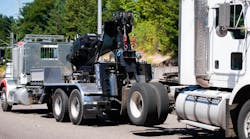The ongoing push on Capitol Hill to allow states to raise highway truck weight limits from 80,000 lbs. to 97,000 lbs. remains a tough sell according to some transportation experts, largely because the general public still views the trucking industry in a negative light.
Stu MacKay, president of market research firm MacKay & Company, said that obtaining an increase in tractor-trailer weight limits “remains a rough road to drive down.”
He added: “We’ve kicked around this idea before, raising the truck weight limit. My feeling is that there would be some benefit for TL carriers, as they tend to load to gross weight capacity - versus LTL carriers, which tend to ‘cube out’ their trailers - though some would see an advantage” from a higher weight allowance.
MacKay made his comments during a conference call with reporters hosted this week by H. Peter Nesvold, managing director of equity research for Jeffries & Co.
“But my gut tells me getting 97,000 lbs. will be tough,” MacKay added. “The public tends to see trucks as a nuisance. Then there’s the infrastructure issue; the states and the federal government simply don’t have the money to invest in the infrastructure upgrades required to handle heavier trucks.”
Indeed, the International Brotherhood of Teamsters noted that very point at an event on Capitol Hill earlier this month as part of the group’s effort to pass the Safe Highways and Infrastructure Preservation Act (SHIPA), legislation that would restrict the size and weight of trucks that travel U.S. highways.
Teamster’s General President James Hoffa pointed to a nationwide poll that claimed 89% of the general public strongly opposes larger trucks, both in terms of safety and impact on highway infrastructure.
“Large trucks are more dangerous to drive and damage highways and bridges,” he said. “As the nation’s infrastructure ages, heavier trucks will only accelerate the wear and tear. Nearly half of the nation’s bridges are more than 40 years old, with one in four structurally deficient or functionally obsolete.”
MacKay also noted that truck productivity has skyrocketed to such an extent over the last two decades that size and weight increases may not be necessary – or profitable.
“One of the reasons many carriers themselves oppose higher weight allowances now, as in the past, is that they’d be hauling more freight for the same rate,” he explained.
The reason is related to improved trucking productivity. For example, in the 1970s, 41,500 new Class 8 truck were needed to handle every $100 billion worth of truck freight-related economic activity, according to MacKay & Co.’s data. By the 1980s, that number shrank to 30,000 Class 8 units, rising slightly to 32,000 in the 1990s before falling to 22,000 units by the first decade of the 21st century.
The same type of shrinkage occurred in the trailer population over the same period as well, MacKay added – with the number of new trailers needed to handle every $100 billion worth of trucking economic activity falling by 50%.
“The significant degree of improved productivity we’ve seen in trucking since industry deregulation [in 1981] means we need fewer of them,” he said. “The industry is twice as productive as it was 40 years ago.”
What MacKay believes will step in and fill the “capacity breech” existing in the truck freight right now won’t be size & weight rule changes but more intermodal activity, specifically truck-rail transport combinations.
“Fuel costs are up, the number of available drivers is down, and regulatory changes from hours of service to CSA are impacting trucking operations, so carriers need other options,” he explained. “ It used to be that intermodal only worked with lengths of haul 1,000 miles or greater. Then it dropped to 700 to 800 miles. Now it’s down to 400 miles in some cases. So we expect to see more intermodal business as a result.”



